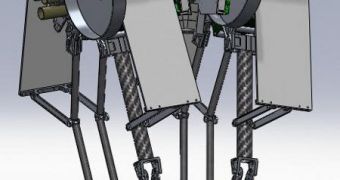One of the main obstacles preventing the development of advanced robots today is the fact that scientists have yet to figure out how to make machines that can walk and run efficiently. The robots that do so today are very clumsy, prone to errors, and also inefficient in terms of energy consumption. A group of experts at the Oregon State University (OSU) is currently working on the problem from both angles, in an attempt to design machines that can run with ease, without consuming the vast amounts of power they need today. This could pave the way for people to use robots for common tasks, which require only a moderate degree of autonomy.
“Researchers have been working toward robot locomotion for a long time based mostly on experience and intuition. What we've done is taken a step back to analyze the fundamental dynamics of the mechanical system, what behavior is really possible for a given robotic system. A rock can't fly, no matter what software you write for it. This is an important advance and gives us a new foundation to tell what actually will and won't work before we even try to build it,” says OSU assistant professor of robotics and mechanical design Jonathan Hurst, who is a member of the research team at the university.
The US National Science Foundation (NSF), through the Human Frontiers Science Program, awarded the OSU team more than $750,000 in grant money for this investigation. The findings, which were made at the university's Dynamic Robotics Laboratory, were presented at the most recent IEEE Conference on Robotics and Automation, as well as in another workshop. The scientists who conducted the presentations told attendants that the first robotic prototype designed under the new specifications was scheduled for completion later this summer. The experts, however, underlined that many issues needed to be resolved first. There are extreme differences between how a machine walks, and how humans and animals do the same thing.
“If robotic locomotion is ever to achieve some of what we want, it will have to use less energy. There are machines that can walk with no active controls at all, using barely any energy, but they fall if they run into the smallest bump. We need to use as much of that passive ability as possible and only use motors or active controls if it's really necessary, so we can save energy in the process,” Hurst believes.
“Long term, there's no reason we shouldn't be able to build robots or robotic devices with excellent locomotion ability. Clearly this might be useful for some military or police applications in highly dangerous situations. But I could also see great improvements possible with prosthetic limbs that work much better than existing technology, or even the creation of exoskeletons that might allow someone with limited motor ability to walk effectively,” he concludes.

 14 DAY TRIAL //
14 DAY TRIAL //